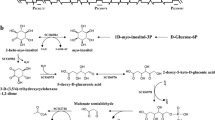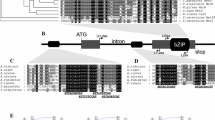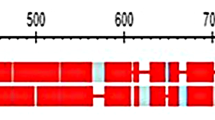Abstract
HGT1 encodes a high-affinity glutathione transporter in the yeast Saccharomyces cerevisiae that is induced under sulphur limitation. The present work demonstrates that repression by organic sulphur sources is under the control of the classic sulphur regulatory network, as seen by the absence of expression in a met4Δ background. Cysteine appeared to be the principal regulatory molecule, since elevated levels were seen in str4Δ strains (deficient in cysteine biosynthesis) that could be repressed by elevated levels of cysteine, but not by methionine or glutathione. Investigations into cis-regulatory elements revealed that the previously described motif, a 9-bp cis element, CCGCCACAC, located at the −356 to −364 region of the promoter could in fact be refined to a 7-bp CGCCACA motif that is also repeated at −333 to −340. The second copy of this motif was essential for activity, since mutations in the core region of the second copy completely abolished activity and regulation by sulphur sources. Activity, but not regulation, could be restored by reintroducing an additional copy upstream of the first copy. A third region, GCCGTCTGCAAGGCA, conserved in the HGT1 promoters of the different Saccharomyces spp, was observed at −300 to −285 but, while mutations in this region did not lead to any loss in repression, the basal and induced levels were significantly increased. In contrast to a previous report, no evidence was found for regulation by the VDE endonuclease. The strong repression at the transport level by glutathione seen in strains overexpressing HGT1 was due to a glutathione-dependent toxicity in these cells.








Similar content being viewed by others
References
Anderson ME (1985) Determination of glutathione and glutathione disulphide in biological samples. Methods Enzymol 113:548–555
Ballatori N, Dutczak WJ (1994) Identification and characterization of high and low affinity transport systems for reduced glutathione in liver cell canalicular membranes. J Biol Chem 269:19731–19737
Blaiseau PL, Thomas D (1998) Multiple transcriptional activation complexes tether the yeast activator Met4p to DNA. Eur Mol Biol Org J 17:6627–6336
Blaiseau P, Isnard A, Surdin-Kerjan Y, Thomas D (1997) Met31p and Met32p, two related zinc proteins, are involved in transcriptional regulation of yeast sulphur amino acid metabolism. Mol Cell Biol 17:3640–3648
Bourbouloux A, Shahi P, Chakladar A, Delrot S, Bachhawat AK (2000). Hgt1p, a high affinity glutathione transporter from the yeast Saccharomyces cerevisiae. J Biol Chem 275:13259–13265
Chaudhuri B, Ingavale S, Bachhawat AK (1997) apd1+, a gene required for red pigment formation in ade6 mutants of Schizosaccharomyces pombe, encodes an enzyme required for glutathione biosynthesis: a role for glutathione and a glutathione-conjugate pump. Genetics 145:75–83
Cliften PF, Hillier LW, Fulton L, Graves T, Miner T, Gish WR, Waterston RH, Johnston M (2001) Surveying Saccharomyces genomes to identify functional elements by comparative DNA sequence analysis. Genome Res 11:1175–1186
Cliften P, Sudarsanam P, Desikan A, Fulton L, Fulton B, Majors J, Waterston R, Cohen BA, Johnston M (2003) Finding functional features in Saccharomyces genomes by phylogenetic footprinting. Science 301:71–76
Curie C, Panaviene Z, Loulergue C, Dellaporta SL, Brait JF, Walker EL (2001) Maize yellow stripe1 encodes a membrane protein directly involved in Fe(III) uptake. Nature 409:346–350
Dormer UH, Westwater J, McLareu NF, Kent NA, Miller J, Jamieson DJ (2000) Cadmium inducible expression of the yeast GSH1 gene requires a functional amino acid regulatory network. J Biol Chem 275:32611–32616
Gimble FS, Thorner J (1992) Homing of a DNA endonuclease gene by meiotic gene conversion in Saccharomyces cerevisiae. Nature 357:301–306
Gimble FS, Thorner J (1993) Purification and characterization of VDE, a site-specific endonuclease from the yeast Saccharomyces cerevisiae. J Biol Chem 268:21844–21853
Grant CM, MacIver FH, Dawes IW (1996) Glutathione is an essential metabolite required for resistance to oxidative stress in Saccharomyces cerevisiae. Curr Genet 29:511–515
Guarente L (1983) Yeast promoters and LacZ fusions designed to study expressions of cloned genes in yeast. Methods Enzymol 101:181–191
Guarente L, Ptashne M (1981) Fusion of Escherichia coli Lac Z to the cytochrome c gene of Saccharomyces cerevisiae. Proc Natl Acad Sci USA 78:2199–2203
Hansen J, Johannesen PF (2000) Cysteine is essential for transcriptional regulation of the sulphur assimilation genes in Saccharomyces cerevisiae. Mol Gen Genet 263:535–542
Hauser M, Donhardt AM, Barnes D, Naider F, Becker JM (2000) Enkephalins are transported by a novel eukaryotic peptide uptake system. J Biol Chem 275:3037–3041
Jamai A, Tommasini R, Martinoia E, Delrot S (1996) Characterization of glutathione uptake in broad bean leaf protoplasts. Plant Physiol 111:1145–1152
Kellis M, Patterson N, Endrizzi M, Birren B, Lander ES (2003) Sequencing and comparison of yeast species to identify genes and regulatory elements. Nature 423:241–254
Kohli DK, Bachhawat AK (2003) CLOURE: Clustal Output Reformatter, a program for reformatting Clustal X/Clustal W outputs for SNP analysis and molecular systematics. Nucleic Acids Res 31:3501–3508
Kohli DK, Srikanth CV, Bachhawat AK (2004) A search tool for identification and analysis of conserved sequence patterns in Saccharomyces spp orthologous promoter. In Silico Biol 4:411–415
Kumar C, Sharma R, Bachhawat AK (2003) Utilization of glutathione as an exogenous sulphur source is independent of γ-glutamyl transpeptidase in the yeast Saccharomyces cerevisiae: evidence for an alternate gluathione degradation pathway. FEMS Micobiol Lett 219:187–194
Kuras L, Cherest H, Surdin-Kerjan Y, Thomas D (1996) A hetromeric complex containing the centromere binding factor 1 and two basic leucine zipper factors, Met4 and Met28, mediates the transcription activation of yeast sulphur metabolism. Eur Mol Biol Org J 15:2519–2529
Li ZS, Szczypka M, Lu YP, Thiele DJ, Rea PA (1996) The yeast cadmium factor protein (YCF1) is a vacuolar glutathione S-conjugate pump. J Biol Chem 271:6509–6517
Lubkowitz MA, Barnes D, Bresiav M, Burchfield A, Naider F, Becker JM (1998). Schizosaccharomyces pombe isp4 encodes a transporter representing a novel family of oligopeptide transporters. Mol Microbiol 28:729–741
Meister A, Anderson ME (1983) Glutathione. Annu Rev Biochem 52:711–760
Miyake T, Hazu S, Yoshida S, Kanayama M, Tomochika KI, Shinoda S, Ono BI (1998) Glutathione transport systems of budding yeast Saccharomyces cerevisiae. Biosci Biotechnol Biochem 62:1858–1864
Miyake T, Kanayama M, Sammoto H, Ono B (2002) A novel cis-acting cysteine-responsive regulatory element of the gene for the high-affinity glutathione transporter of Saccharomyces cerevisiae. Mol Genet Genomics 266:1004–1011
Miyake T, Hiraishi H, Sammoto H, Ono B (2003) Involvement of the VDE homing endonuclease and rapamycin in regulation of the Saccharomyces cerevisiae GSH11 gene encoding the high affinity glutathione transporter. J Biol Chem 278:39632–39636
Ono B, Kijima K, Shirahige Y, Yamamoto M (1991) Regulation of cystathione γ-lyase in Saccharomyces cerevisiae. Yeast 7:843–848
Ono BI, Kijima K, Ishii N, Kawato T, Matsuda A, Paszewski A, Shinoda S (1996) Regulation of sulphate assimilation in Saccharomyces cerevisiae. Yeast 12:1153–1162
Pineda-Molina E, Klatt P, Vazquez J, Marina A, Lacoba MG de, Perez-Sala D, Lamas S (2001) Glutathionylation of the p50 subunit of NF-kB: a mechanism for redox-induced inhibition of DNA binding. Biochemistry 40:14134–14142
Sharma KG, Sharma V, Bourbouloux A, Delrot S, Bachhawat AK (2000) Glutathione depletion leads to delayed growth stasis in Saccharomyces cerevisiae: evidence for partially overlapping role of thioredoxin. Curr Genet 38:71–77
Sherrill C, Fahey RC (1998) Import and metabolism of glutathione by Streptococcus mutants. J Bacteriol 180:1454–1459
Stephen DW, Jamieson DJ (1997) Amino acid-dependent regulation of the Saccharomyces cerevisiae GSH1 gene by hydrogen peroxide. Mol Microbiol 23:203–210
Thomas D, Cherest H, Surdin-Kerjan Y (1989) Element involved in S-adenosylmethionine-mediated regulation of the Saccharomyces cerevisiae MET25 gene. Mol Cell Biol 9:3292–3298
Thomas D, Jacquemin I, Surdin-Kerjan Y (1992) MET4 a leucine zipper protein, and centromere binding factor 1, are both required for transcriptional activation of sulphur metabolism in Saccharomyces cerevisiae. Mol Cell Biol 12:1719–1727
Thompson JD, Higgins DG, Gibson TJ (1994) CLUSTAL W: improving the sensitivity of progressive multiple sequence alignment through sequence weighting, position-specific gap penalties and weight matrix choice. Nucleic Acids Res 22:4673–4680
Wang J, Boja ES, Tan W, Tekle E, Fales HM, English S, Mieyal JJ, Chock PJ (2001) Reversisble glutathionylation regulates actin polymerization in A431 cells. J Biol Chem 276:47763–47766
Wheeler GL, Trotter EW, Dawes IW, Grant CM (2003) Coupling of the transcriptional regulation of glutathione biosynthesis to the availability of glutathione and methionine via the Met4p and Yap1p transcription factors. J Biol Chem 278:49920–49928
Wu AL, Moye-Rowley S (1994) GSH1, which encodes γ-glutamyl cysteine synthetase is a target for the yAP-1p transcriptional activator. Mol Cell Biol 14:5832–5839
Zheng-Zheng S, Osei-Frimpong J, Kala G, Kala SV, Barrios R, Habib GM, Lukin DJ, Dannry CM, MatZuk MM, Lieberman MW (2000). Glutathione synthesis is essential for mouse development but not for cell growth in cell culture. Proc Natl Acad Sci 97:5501–5506
Acknowledgements
We thank Raj Kumar for technical assistance and Jaspreet Kaur for help in carrying out the cadmium and diamide experiments. We thank Dr. Tom Stevens (University of Oregon, Eugene, Ore.), Dr. Johanssen (Carlsberg Research Laboratory, Copenhagen Valby, Denmark) and Dr. Fred Gimble (University of Texas, Austin, Tex.) for the gift of strains and plasmids. This work was supported by Grant-in-Aid projects to A.K.B. from the Department of Biotechnology, Government of India, and a Grant-in-Aid project from the Indo-French Centre for the Promotion of Advanced Research (2700-B1) to A.K.B. and S.D. C.V.S. was the recipient of a Research Fellowship from the Council of Scientific and Industrial Research, Government of India.
Author information
Authors and Affiliations
Corresponding author
Additional information
Communicated by S. Hohmann
Rights and permissions
About this article
Cite this article
Srikanth, C.V., Vats, P., Bourbouloux, A. et al. Multiple cis-regulatory elements and the yeast sulphur regulatory network are required for the regulation of the yeast glutathione transporter, Hgt1p. Curr Genet 47, 345–358 (2005). https://doi.org/10.1007/s00294-005-0571-7
Received:
Revised:
Accepted:
Published:
Issue Date:
DOI: https://doi.org/10.1007/s00294-005-0571-7




